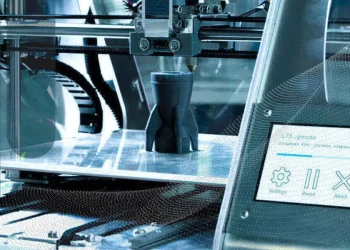Over its thirty-plus year history, 3D printing has been a game-changer for the manufacturing of products. Technological advances in the industry have repeatedly changed the way engineers design products and how they make them. And the industry is not done. The progress coming to the market now and in the next few years will change the way we make things again. And, this change will be a competitive advantage for firms that understand what is driving the advances and how to leverage the improvements.
How has 3D printing changed manufacturing in the past?
This technology often referred to as additive manufacturing or AM, began as a better way to create prototypes during product design. Engineers could get models in a day or two instead of weeks or months. As machines and materials improved, the quality of those prototypes improved, enabling products to get to market even faster and with fewer problems. The next significant change was using 3D printing to create tooling for manufacturing – jigs, fixtures, and patterns created directly from computer models in a matter of hours.
Those improvements in materials and build quality continued until it became practical to create production parts and assemblies using 3D printing for complicated parts that are customized or made in low volume. Companies like General Electric started making jet engine parts with 3D printing instead of traditional manufacturing that was more expensive or took too long. These types of high-value components, created in relatively low volumes, highlighted the advantages of additive manufacturing.
And now the industry is at it again. Multiple vendors, both established additive manufacturing players and startups, have introduced or are about to launch high-volume printing systems that deliver the advantages of 3D printing at a competitive price when making hundreds of thousands of parts.
Why is 3D printing different from traditional manufacturing?
Engineers refer to 3D printing as additive manufacturing because it is a manufacturing method that creates objects by adding material. For tens of thousands of years, humans have made things out of raw materials by either removing material, shaping it, or molding it. We have fabricated everything from flint arrowheads to the pump in a rocket engine using some combination of these basic methods. In contrast, 3D printing creates a part by depositing material one thin layer at a time. That material started as plastic and has grown to include metals, gels, concrete, and even chocolate. The most common systems squirt out the material through a nozzle, like a robot controlled glue gun. Others use lasers, adhesives, and heat to melt or bind powdered plastic or metal. And others use light to turn a liquid substance into a solid. What all the various methods have in common is that they create a solid shape one thin layer at a time.
By building an object up, the limitations of traditional manufacturing fade away. The dominant way to make plastic parts today is to melt plastic, inject it into a metal mold, let it harden, then pop it out. Although the mold itself can cost between ten and a hundred thousand dollars, this method allows you to make millions of parts very quickly. And that volume makes the per-piece price low. But, this approach, called injection molding, has many limitations on the shapes you can create. 3D printing does not have those limitations. The same constraints exist when cutting material away from a block of steel or aluminum. You have to be able to get a cutting tool into the bends and folds of a part, and that limits what designers can create. Or, to get a complicated product, you have to make lots of simple components and assemble them.
With additive manufacturing, you can create complex parts and assemblies in one build. And using a 3D printer does not require the training and experience that injection molding, metal cutting, or other traditional methods need. It is fast, flexible, and accessible to anyone.
What has changed to make high volume additive manufacturing inexpensive?
The problem, untill now, is that most 3D printing machines could make only a few parts at a time. It still took too long to make each part and the machine cost per piece made was too high. It only made sense for complex, custom, or low volume productions.
The equipment manufacturers saw this limitation and are creating larger machines that are considerably faster. Even paper printing giant HP used their expertise in inkjet printing to create a 3D printer that can make hundreds of parts very quickly in a giant block of powder. A handful of companies, including 3D Printing industry veterans ExOne and Stratasys, tech giant GE, and startups Desktop Metal and MarkForged, have developed machines to glue small particles of metal together that are then put into an oven and melted into a solid part in a process called sintering. Still others, like Carbon, use light projectors and added chemicals to quickly solidify liquid plastic into a solid.
Some of these systems are available today, and others will be released to the market in the next couple of years. Many firms are working on this tech with the expectation that the demand for large volume 3D printing will explode with the faster speed and lower per-piece cost that these new devices will enable.
How can companies take advantage of this change?
Manufacturing companies that recognize the potential of high-volume 3D printing early will have a competitive advantage. They will get products to market faster and not be as vulnerable to geopolitical uncertainty or skilled labor shortages that impact traditional methods. The additive approach to shaping geometry will also deliver additional design freedom to realize components that perform better or that require fewer assembly steps. And, if done right, they can recognize all of these benefits at a lower cost.
The first step companies can take is an evaluation of their existing or planned products to see which ones would benefit from the advantages of 3D printing. Next, find a production service provider that understands the new high-volume additive manufacturing process and, using their advice, modify the product design to optimize the advantages of whichever system fits best.
The critical step is to then obtain cost information for the entire process from production start to placing the finished product in packaging. Compare that cost to traditional manufacturing to determine if it is time to adopt high-volume additive manufacturing production. It may even justify bringing these new machines into your manufacturing facilities.
After doing a thorough investigation, you may find that only a few components in your product will benefit from this approach. Perhaps, the way you make things right now will continue to be the best way. Or, if the fit is just right, you can take advantage of this coming manufacturing revolution and not just outperform your competition, you might leverage it to disrupt your industry.

Eric Miller
As an industry veteran of 34 years, Eric Miller has perfected a diverse set of skills that he implements as co-owner and principal of Tempe-based PADT. His role encompasses oversight of simulation and product development consulting, IT, marketing, operations, human resources and administration.
Miller graduated from the University of California, Berkeley with a Bachelor of Science in mechanical engineering. He began his career as a summer intern at Lockheed doing design work on satellite subsystems. After college, Miller provided simulation and process improvement services to Garrett Turbine Engines in Phoenix (now Honeywell) for a total of eight years.
Miller is not only a successful businessman and engineer but also a mentor to startups and small businesses. He often speaks on the use of simulation to drive product development, as well as the effective application of 3D printing. Miller serves as Chairman of the Arizona Technology Council’s Board of Directors, a member of the BioAccel Advisory Council, a screening committee member of Arizona Technology Investors, and a mentor for the Arizona Commerce Authority’s (ACA) Venture Ready program.
Miller recently published his first book, “Better Blogging for your Business,” now available on Amazon.








